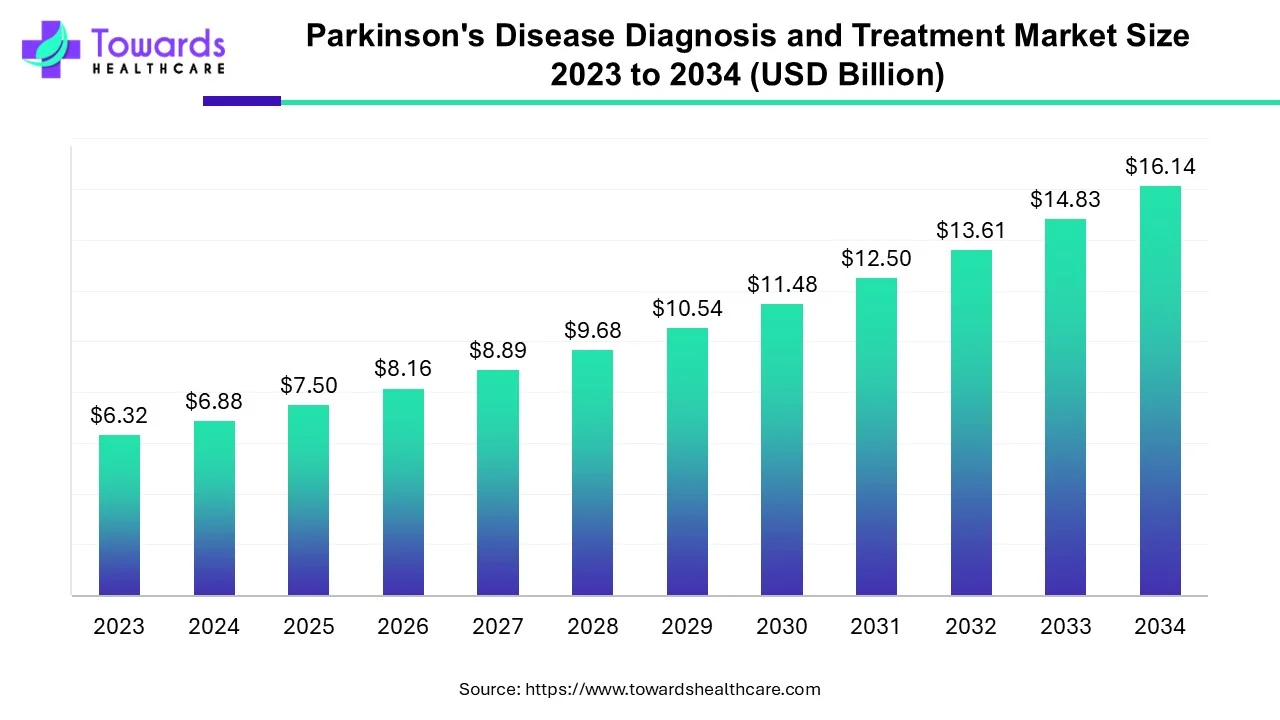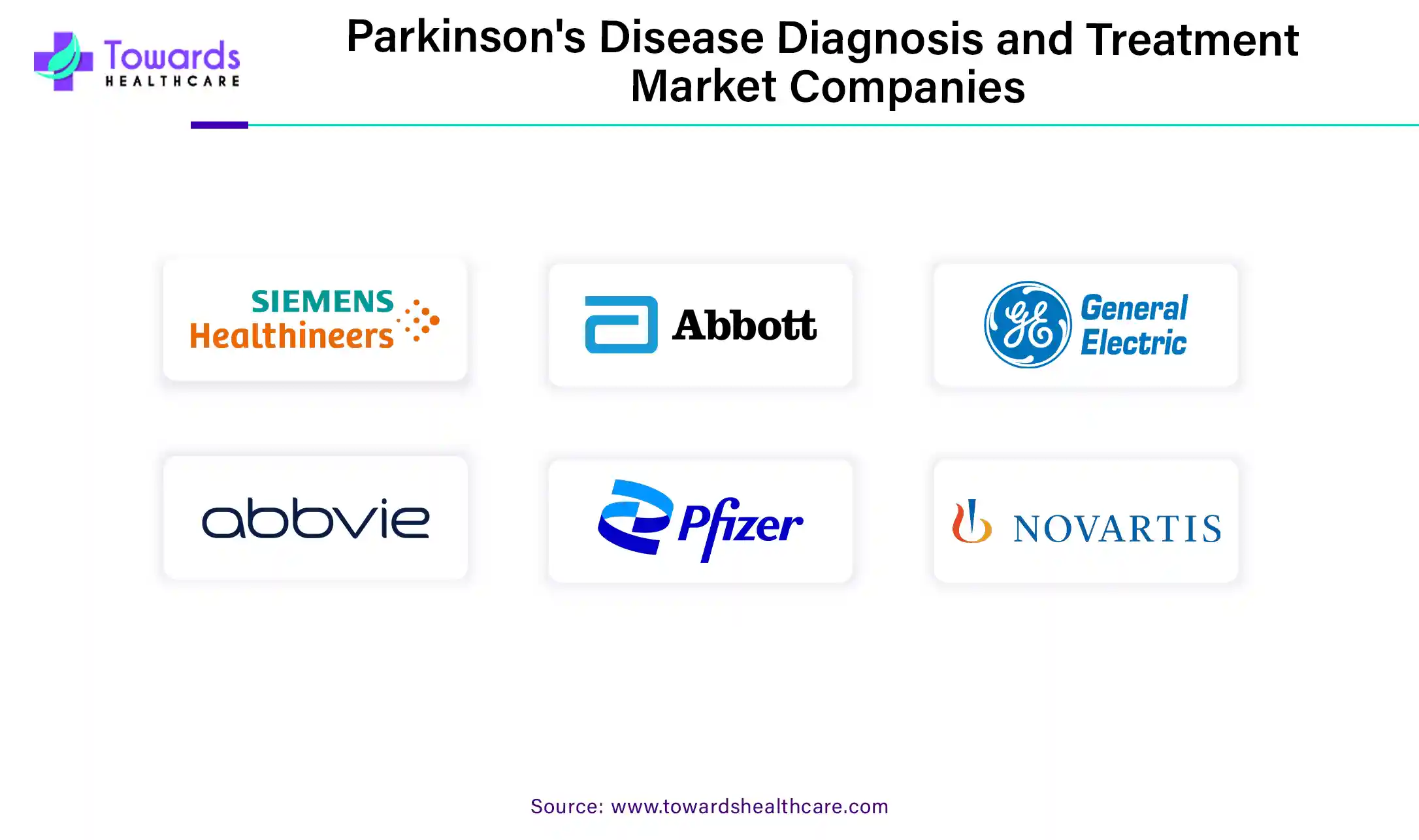
The Parkinson’s disease diagnosis and treatment market is expected to increase from USD 7.5 billion in 2025 to USD 16.14 billion by 2034, growing at a CAGR of 8.9% throughout the forecast period from 2025 to 2034.

According to Parkinson’s News Today, about 41 out of every 100,000 people in their 40s are affected by Parkinson’s disease. This number increases to more than 1,900 out of every 100,000 for people in their 80s and 90s. Parkinson's is the second most common neurodegenerative disorder, after Alzheimer’s disease. Right now, there's no cure for Parkinson's, and people with the condition need lifelong medication support.
Parkinson's disease is a neurological disorder characterized by involuntary movements such as tremors, stiffness, and difficulty with coordination. Symptoms usually develop gradually and worsen over time, affecting mobility, speech, and cognition. While the exact cause is unclear, research suggests a combination of genetic and environmental factors may contribute to the disease's onset. Parkinson's primarily affects the basal ganglia in the brain, leading to a decrease in dopamine production and subsequent movement problems. Despite ongoing research, the exact reasons for nerve cell death in Parkinson's remain unknown.
Parkinson's has four major symptoms:
There is a lot of interest in finding a treatment that will help slow the progression of Parkinson's disease. These are known as neuroprotective or disease-modifying drugs. The idea is based on the notion that dopamine-producing neurons can be protected from premature death and dopamine depletion.
At this point, no treatment is neuroprotective. Numerous treatments have been investigated, including MAO-B inhibitors, dopamine agonists, coenzyme Q10, and vitamin E. There is insufficient evidence to conclude that these therapies are beneficial, and they are not currently recommended to slow the Parkinson's disease. Several clinical trials are being conducted to identify disease-modifying drugs.
It's really important to find out if someone has Parkinson's early and give them the right treatment. This can help them manage their symptoms better and have a better quality of life.
Parkinson's disease (PD) is a condition that affects the brain and causes problems with movement, like shaking, stiffness, and slow movements. It's becoming more common worldwide, especially in places where people are living longer lives. As more people get older, the number of those diagnosed with PD goes up.
For instance,
With more people getting Parkinson's, there's a bigger need for tools to help doctors find out if someone has it. These tools include things like scans and tests that can see inside the brain to spot signs of PD. When PD is detected early, doctors can start treatment sooner, which can help manage symptoms better and improve quality of life.
Alongside diagnosis, there's also a growing demand for treatments. Medicines that help control PD symptoms are becoming more important. These drugs can help reduce shaking, stiffness, and other issues caused by Parkinson's, allowing people to live more comfortably.
But it's not just about medicines. As Parkinson's progresses, people often need additional support. This includes therapies like physical therapy to keep muscles strong and occupational therapy to assist with everyday tasks. With more attention on Parkinson's disease, there's also more focus on research. Scientists are working hard to understand the disease better and develop new treatments. This research leads to discoveries that can improve the lives of those with PD.
Advancements in medical technology, such as deep brain stimulation (DBS) and infusion therapies, are aiding individuals with Parkinson's disease (PD) by offering innovative treatment options. Deep brain stimulation involves implanting tiny electric wires in the brain to manage PD symptoms, while infusion therapies deliver medication directly into the body. These advancements contribute to improving patient care. The total cost of Parkinson's disease in the United States, covering treatment expenses, social security aid, and lost income, is estimated to be around $52 billion annually.
These innovations are a big deal because they expand the choices for treating PD. Before, there weren't as many options, but now doctors and patients have more to choose from. This means better outcomes for patients – their symptoms can be managed more effectively, helping them feel better and live more comfortably.
For instance,
And infusion therapies can provide a steady flow of medication, ensuring that patients get the right amount at the right time. Because these treatments work so well, more people want them. This creates a bigger market for companies that make these devices and therapies. They can sell more products, which means they can invest more in research and make even better treatments in the future.
A study supported by the Parkinson's Foundation in 2022 found that around 90,000 individuals receive a diagnosis of Parkinson's disease in the United States every year. This marks a significant 50% rise from the earlier estimated figure of 60,000 diagnoses per year. Advancements in treating Parkinson's disease (PD) are making a big impact on the market for PD diagnosis and treatment. Imagine you have a toolbox, and every time you find a new tool that works better, more people want to use it. That's what's happening with PD treatments. Infusion therapy, which delivers medicine directly into the body. These treatments offer new options for managing PD symptoms and improving quality of life.
As more effective treatments become available, more people are seeking help. This increased demand for treatment options is driving growth in the PD market. Companies that make these treatments can sell more products and invest more in research to make even better treatments in the future.
But it's not just about treatments – better diagnosis tools are also making a difference. When doctors can identify PD earlier, they can start treatment sooner, which can slow down the progression of the disease and improve outcomes for patients.
Diagnosing Parkinson's disease early on can be tough because its symptoms aren't always obvious and can resemble those of other health problems. Sometimes, individuals may not even realize they have Parkinson's because the signs are subtle. This makes it hard for doctors to identify the disease quickly and start the right treatment. It's like trying to find the right answer in a big book with lots of similar-looking pages – you need time to carefully examine each one to find the correct information. Similarly, doctors need time and specific tests to carefully study the symptoms and confirm if it's Parkinson's. Getting an early diagnosis is important because it lets doctors begin treatment sooner. Starting treatment early can help manage symptoms more effectively and improve the person's quality of life.
North America is home to leading pharmaceutical companies, biotechnology firms, and academic research institutions that are actively engaged in developing new therapies, diagnostic tools, and disease-modifying treatments for Parkinson's disease. North America has a significant aging population, with a large proportion of individuals aged 65 and older. As PD is more common in older adults, this demographic trend contributes to the prevalence of the disease in the region. The regulatory landscape in North America, particularly in the United States and Canada, plays a crucial role in shaping the market for PD diagnosis and treatment. Approval processes for new drugs, medical devices, and treatment modalities impact market entry and commercialization strategies.
The Asia-Pacific region is home to a diverse population, including both rapidly aging populations in countries like Japan and South Korea and younger populations in countries like India and Indonesia. The increasing prevalence of Parkinson's disease, particularly in aging populations, drives demand for diagnosis and treatment options. Research and development activities in Parkinson's disease diagnosis and treatment are gaining traction in the Asia-Pacific region, with academic institutions, healthcare organizations, and pharmaceutical companies collaborating to address unmet medical needs and develop innovative solutions.
The competitive landscape for Parkinson's disease diagnosis and treatment market is like a race among different companies. Each company tries to offer the best products and services to attract patients and healthcare providers. They compete by developing new medications, diagnostic tools, and treatment methods. Some companies may focus on affordability, while others emphasize innovation. It's a dynamic environment where companies strive to stay ahead by offering effective solutions and staying up-to-date with advancements in the field.

By Diagnosis
By Treatment
By Geography